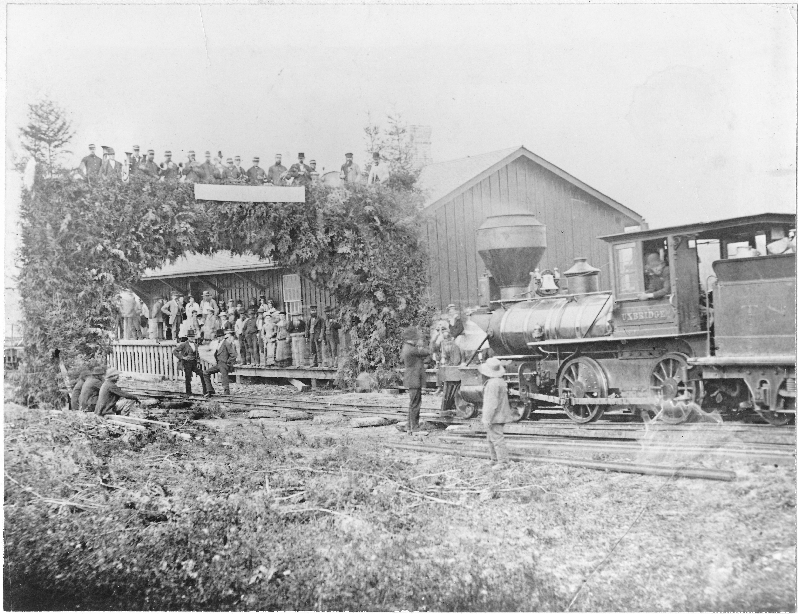|
Lake Simcoe Junction Railway
The Lake Simcoe Junction Railway (LSJR) was a short-line narrow gauge railway in Ontario just north of Toronto. It branched off the Toronto and Nipissing Railway at Stouffville and ran north to the town of Sutton and then beyond to the shore of Lake Simcoe where a large wharf was built. The presence of the railway helped the town of Jackson's Point form on the lakeside. The line serviced timber and agricultural shipping, but was more widely used for shipping ice cut from the lake in the winter, and allowing weekend day trips to the lake in the summer. The arrival of the Toronto and York Radial Railway at Sutton in 1908 took most of the summertime passenger business away, and the introduction of refrigeration did the same for the wintertime ice business. Service ended to the Point in September 1927 and the rails were lifted. Service below Sutton continued through a connection to the standard gauge Canadian Northern Railway (CNoR), west of the town of Zephyr. It saw some use d ... [...More Info...] [...Related Items...] OR: [Wikipedia] [Google] [Baidu] |
Narrow Gauge
A narrow-gauge railway (narrow-gauge railroad in the US) is a railway with a track gauge narrower than standard . Most narrow-gauge railways are between and . Since narrow-gauge railways are usually built with tighter curves, smaller structure gauges, and lighter rails, they can be less costly to build, equip, and operate than standard- or broad-gauge railways (particularly in mountainous or difficult terrain). Lower-cost narrow-gauge railways are often used in mountainous terrain, where engineering savings can be substantial. Lower-cost narrow-gauge railways are often built to serve industries as well as sparsely populated communities where the traffic potential would not justify the cost of a standard- or broad-gauge line. Narrow-gauge railways have specialised use in mines and other environments where a small structure gauge necessitates a small loading gauge. In some countries, narrow gauge is the standard; Japan, Indonesia, Taiwan, New Zealand, South Africa, and the Aust ... [...More Info...] [...Related Items...] OR: [Wikipedia] [Google] [Baidu] |
Grand Trunk Railway
The Grand Trunk Railway (; french: Grand Tronc) was a railway system that operated in the Canadian provinces of Quebec and Ontario and in the American states of Connecticut, Maine, Michigan, Massachusetts, New Hampshire, and Vermont. The railway was operated from headquarters in Montreal, Quebec, with corporate headquarters in London, United Kingdom (4 Warwick House Street). It cost an estimated $160 million to build. The Grand Trunk, its subsidiaries, and the Canadian Government Railways were precursors of today's Canadian National Railway. GTR's main line ran from Portland, Maine to Montreal, and then from Montreal to Sarnia, Ontario, where it joined its western subsidiary. The GTR had four important subsidiaries during its lifetime: * Grand Trunk Eastern which operated in Quebec, Vermont, New Hampshire and Maine. *Central Vermont Railway which operated in Quebec, Vermont, Massachusetts, and Connecticut. *Grand Trunk Pacific Railway which operated in Northwestern Ontario ... [...More Info...] [...Related Items...] OR: [Wikipedia] [Google] [Baidu] |
Sutton Radial Station
Sutton (''south settlement'' or ''south town'' in Old English) may refer to: Places United Kingdom England In alphabetical order by county: * Sutton, Bedfordshire * Sutton, Berkshire, a location * Sutton-in-the-Isle, Ely, Cambridgeshire * Sutton, Peterborough, Cambridgeshire * Sutton, Newton, Cheshire * Sutton, Cheshire East, a civil parish in Cheshire ** Sutton Lane Ends, a village in Cheshire * Sutton Weaver, Cheshire West and Chester * Great Sutton, Ellesmere Port, Cheshire * Guilden Sutton, Chester, Cheshire * Little Sutton, Cheshire, Ellesmere Port * Sutton on the Hill, Derbyshire * Sutton Scarsdale, Derbyshire * Sutton, Devon, a hamlet near Kingsbridge * Sutton, a historic name of Plymouth, Devon ** Sutton Harbour, Plymouth, Devon * Sutton Waldron, Dorset * Sutton, Essex * Long Sutton, Hampshire * Sutton Scotney, Hampshire * Sutton, Herefordshire * East Sutton, Kent * Sutton, Kent * Sutton-at-Hone and Hawley, Dartford, Kent * Sutton Valence, Maidstone, Kent ** Su ... [...More Info...] [...Related Items...] OR: [Wikipedia] [Google] [Baidu] |
Midland Railway Of Canada
The Midland Railway of Canada was a historical Canadian railway which ran from Port Hope, Ontario to Midland on Georgian Bay. The line was originally intended to run to Peterborough, but the competing Cobourg and Peterborough Railway was completed in 1854 and the owner's plans changed. Redirecting the line northward, it opened as the Port Hope, Lindsay & Beaverton Railway, a much longer line than originally planned. A further expansion launched in 1869 pushed the line westward towards Georgian Bay, and prompted renaming as the Midland Railway. By the 1880s the area east of Toronto was over-served by a number of short and generally unprofitable lines. Merger plans between the various lines began in 1881, which resulted in the Midland adding a third rail to the Toronto and Nipissing Railway's (T&N) narrow-gauge line to allow Midland trains to follow the T&N lines into Scarborough. The merger was officially completed in 1881. On 10 March 1882 the company arranged an enormous merger ... [...More Info...] [...Related Items...] OR: [Wikipedia] [Google] [Baidu] |
Lard
Lard is a semi-solid white fat product obtained by rendering the fatty tissue of a pig.Lard entry in the online ''Merriam-Webster Dictionary''. Accessed on 2020-07-05. It is distinguished from , a similar product derived from fat of or . Lard can be rendered by steaming, boiling, or dry heat. The culinary qualities of lard vary somewhat depending on the origin and processing method; if properly rendered, it may be nearly odorless and tasteless.E. S. Clifton, Joseph Kastelic, and Be ... [...More Info...] [...Related Items...] OR: [Wikipedia] [Google] [Baidu] |
Lean-to
A lean-to is a type of simple structure originally added to an existing building with the rafters "leaning" against another wall. Free-standing lean-to structures are generally used as shelters. One traditional type of lean-to is known by its Finnish name . Lean-to buildings A lean-to is originally defined as a building in which the rafters lean against another building or wall, a penthouse. These structures frequently have skillion roofs and as such are sometimes referred to as "skillions". A lean-to shelter is a free-standing structure with only three walls and a single-pitched roof. The open side is commonly oriented away from the prevailing winds and rains. Often it is a rough structure made of logs or unfinished wood and used as a camping shelter. A lean-to addition is a shed with a sloping roof and three walls that abuts the wall of another structure. This form of lean-to is generally provisional; it is an appendix to an existing building constructed to fulfill a new need ... [...More Info...] [...Related Items...] OR: [Wikipedia] [Google] [Baidu] |
Whistle Stop
In public transport, a request stop, flag stop, or whistle stop is a stop or station at which buses or trains, respectively, stop only on request; that is, only if there are passengers or freight to be picked up or dropped off. In this way, stops with low passenger counts can be incorporated into a route without introducing unnecessary delay. Vehicles may also save fuel by continuing through a station when there is no need to stop. There may not always be significant savings on time if there is no one to pick up because vehicles going past a request stop may need to slow down enough to be able to stop if there are passengers waiting. Request stops may also introduce extra travel time variability and increase the need for schedule padding. The appearance of request stops varies greatly. Many are clearly signed, but many others rely on local knowledge. Implementations The methods by which transit vehicles are notified that there are passengers waiting to be picked up at a requ ... [...More Info...] [...Related Items...] OR: [Wikipedia] [Google] [Baidu] |
Provincial Gauge
Indian gauge is a broad track gauge of , used in India, Pakistan, western Bangladesh, Sri Lanka, Argentina, Chile, and on BART in San Francisco, United States. In North America, it is called Indian Gauge, Provincial, Portland, or Texas gauge. In Argentina and Chile, it is known as "trocha ancha" (Spanish for ''broad gauge''). In the Indian subcontinent it is simply known as "broad gauge". Elsewhere it is known as Indian gauge. It is the widest gauge in regular passenger use anywhere in the world. Asia India In India, the initial freight railway lines were built using standard gauge. In the 1850s, the Great Indian Peninsula Railway adopted the gauge of for the first passenger railway in India between Bori Bunder and Thane.Indian Railways: Some Fascinating Facts“Train Atlas” ''Train Atlas'', Indian Railways, 2003 This was then adopted as the standard for the nationwide network. Indian Railways today predominantly operates on broad gauge. Most of the metre gauge and narrow ... [...More Info...] [...Related Items...] OR: [Wikipedia] [Google] [Baidu] |
Francis Shanly
Francis may refer to: People *Pope Francis, the head of the Catholic Church and sovereign of the Vatican City State and Bishop of Rome *Francis (given name), including a list of people and fictional characters *Francis (surname) Places *Rural Municipality of Francis No. 127, Saskatchewan, Canada *Francis, Saskatchewan, Canada **Francis (electoral district) *Francis, Nebraska *Francis Township, Holt County, Nebraska *Francis, Oklahoma *Francis, Utah Other uses *Francis (film), ''Francis'' (film), the first of a series of comedies featuring Francis the Talking Mule, voiced by Chill Wills *''Francis'', a 1983 play by Julian Mitchell *FRANCIS, a bibliographic database *Francis (1793), ''Francis'' (1793), a colonial schooner in Australia *Francis turbine, a type of water turbine *Francis (band), a Sweden-based folk band * Francis, a character played by YouTuber Boogie2988 See also *Saint Francis (other) *Francies, a surname, including a list of people with the name *Fran ... [...More Info...] [...Related Items...] OR: [Wikipedia] [Google] [Baidu] |
Uxbridge, Ontario
Uxbridge is a township in the Regional Municipality of Durham in south-central Ontario, Canada. Communities The main centre in the township is the namesake community of Uxbridge. Other settlements within the township include Altona, Coppin's Corners, Forsythe Glenn, Glasgow, Glen Major, Goodwood, Leaskdale, Quaker Village, Roseville, Sandford, Siloam, Udora, and Zephyr. History It was named for Uxbridge, England, a name which was derived from "Wixan's Bridge". The first settlers in the area were Quakers who started arriving in 1806 from the Catawissa, Pennsylvania, Catawissa area of Pennsylvania. The community's oldest building, the Uxbridge Friends Meeting House, was built in 1820 and overlooks the town from Quaker Hill, a kilometre to the west. The township was incorporated as a municipality in 1850 and became part of the newly formed Ontario County, Ontario, Ontario County two years later. The first passenger-carrying narrow-gauge railway in North America, the Toronto ... [...More Info...] [...Related Items...] OR: [Wikipedia] [Google] [Baidu] |
North Bay, Ontario
North Bay is a city in Northeastern Ontario, Canada. It is the seat of Nipissing District, and takes its name from its position on the shore of Lake Nipissing. North Bay developed as a railroad centre, and its airport was an important military location during the Cold War. History The site of North Bay is part of a historic canoe route where Samuel de Champlain took a party up the Ottawa River, through present-day Mattawa, on to Trout Lake and via the La Vase Creek to Lake Nipissing. Apart from Indigenous people, voyageurs and surveyors, there was little activity in the Lake Nipissing area until the arrival of the Canadian Pacific Railway (CPR) in 1882. That was the point where the Canada Central Railway (CCR) extension ended. The CCR was owned by Duncan McIntyre who amalgamated it with the CPR and became one of the handful of officers of the newly formed CPR. The CCR started in Brockville and extended to Pembroke. It then followed a westward route along the Ottawa Ri ... [...More Info...] [...Related Items...] OR: [Wikipedia] [Google] [Baidu] |





